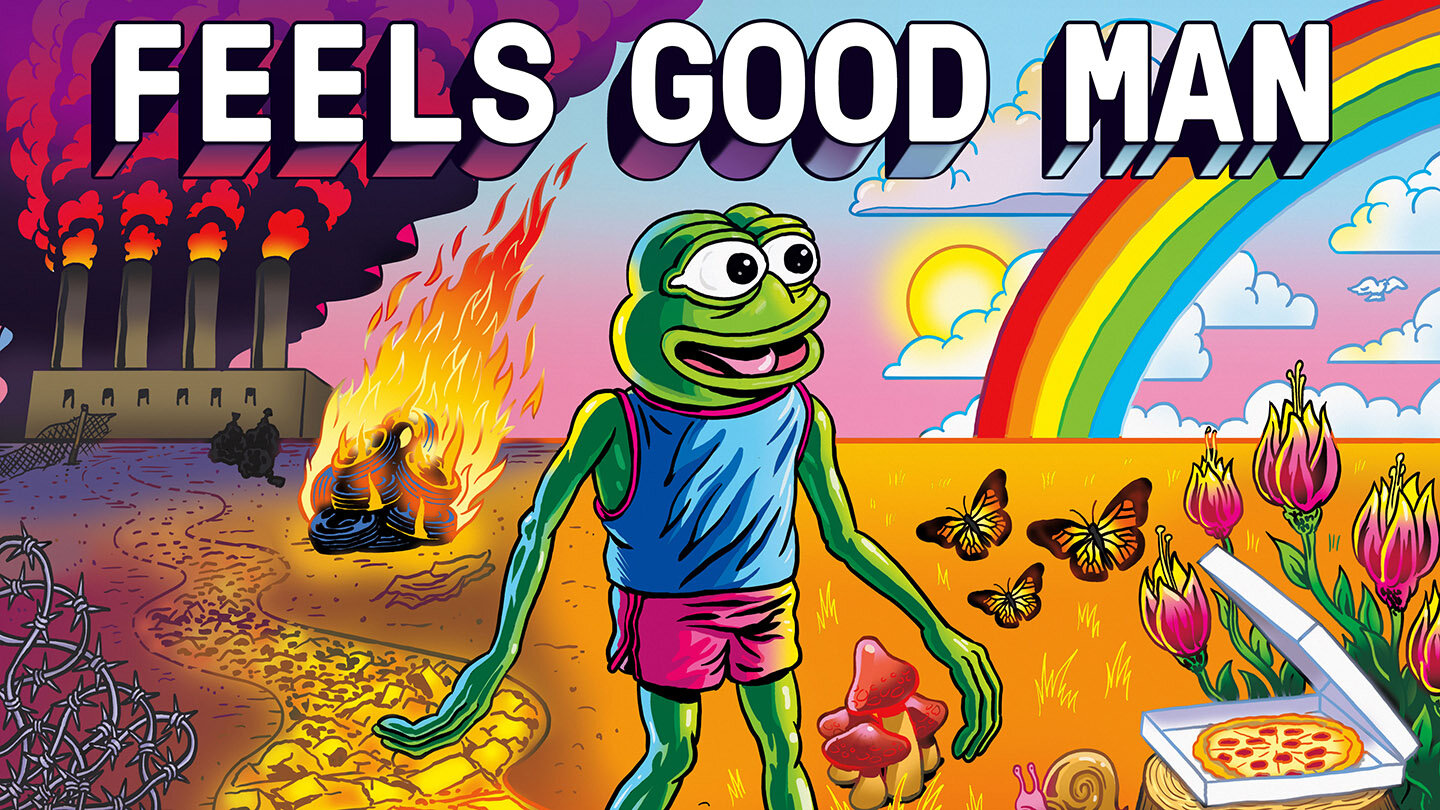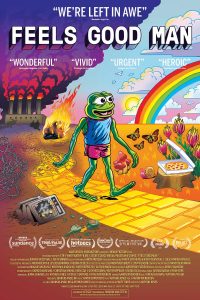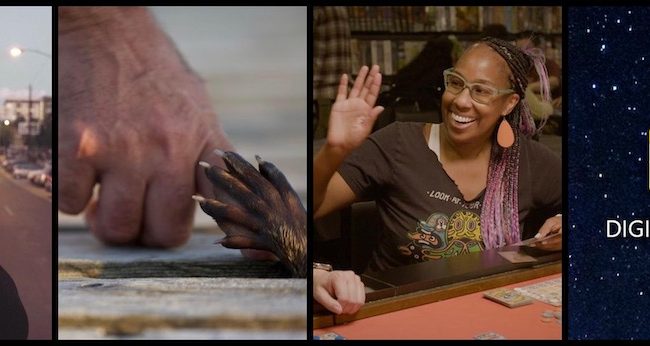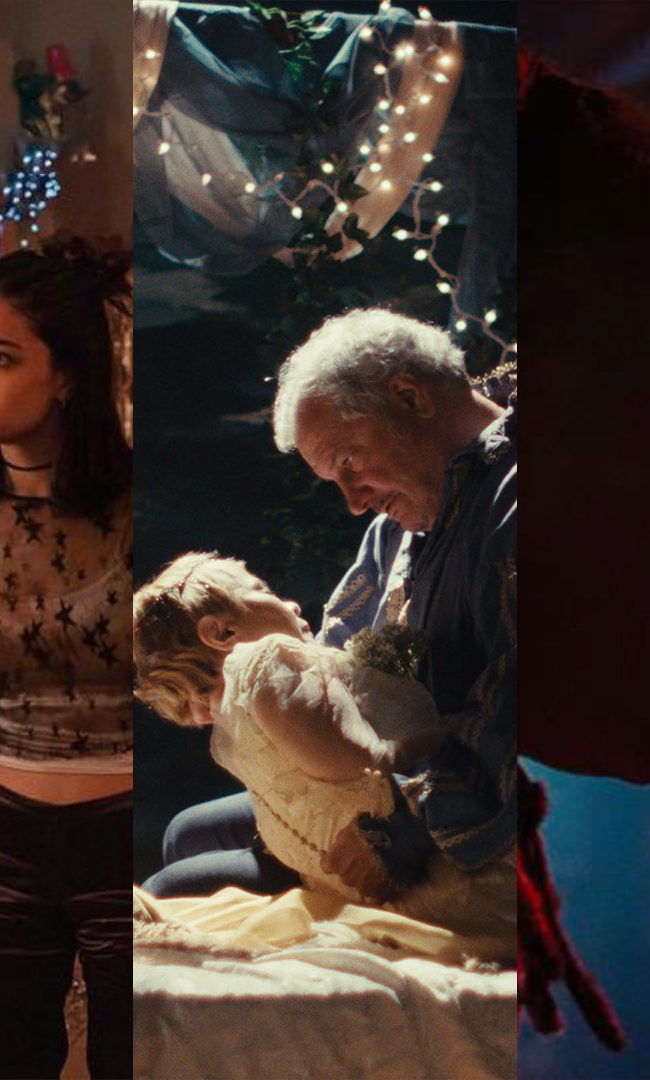A Conversation with Arthur Jones & Giorgio Angelini (FEELS GOOD MAN)

I recently spoke by phone with director Arthur Jones and producer Giorgio Angelini (Owned: A Tale of Two Americas) about their collaboration on the new documentary Feels Good Man (which I also reviewed). The film tells the story of cartoonist Matt Furie’s unwitting creation of a right-wing meme, Pepe the Frog. Originally part of his 2006 comic Boys Club, Pepe slowly developed into something far more sinister in the decade that followed, through no fault of his progenitor. In fact, Furie has actively pushed back against the green guy’s adoption by fascist groups, mostly to no avail, though he has gained some ground, recently. Feels Good Man (the title comes from one of Pepe’s early signature phrases) follows Furie, his partner Aiyana Udesen and their adorable young daughter as they go about their daily lives, exploring how they ended up at the center of an ideological battle they never sought. Joining me in the conversation was my Fog of Truth podcast colleague Bart Weiss (of Dallas VideoFest). Here is a condensed digest of our conversation, edited for length and clarity.
Hammer to Nail: This film is a creative collaboration between the two of you, with Giorgio also doing some of the cinematography and you, Arthur, most of the animation. In practical on-set terms, how did the breakdown of labor work?
Arthur Jones: There was a lot of collaboration on this film between us and then with another producer on the film, Aaron Wickenden, who was also the editor. He has edited a number of other documentary films, like the Mr. Rogers documentary, Won’t You Be My Neighbor?, as well as Finding Vivian Maier. So, the three of us were really kind of the core creative brain trust on the film. And I’m the director, but I really leaned on the expertise of Aaron and Giorgio so much during this process.
I think, in terms of the breakdown, I mean, Giorgio is really an amazing filmmaker in the field, and so there certainly was a lot of beautiful B-roll that was shot for which Giorgio directed those sections. Usually, the interviews would be kind of left up to me. And then a lot of the post-production would start with Aaron and then pass through me and then various animators. But Giorgio and I were in the room together working on this film for a year, and every decision that we made was something that we had long discussions about, we would take to lunch, we would kick around. So it was a really fun process, I think, for all of us.
Giorgio Angelini: People always talk about, especially when they’re accepting awards or something, they’re like, “Oh, this was a really collaborative effort. The whole team’s great.” But no, it really was. I mean, Arthur was very generous in working not just with me, but with all the people who really contributed to the film in meaningful ways. And I think the film and the beauty of the film is really a testament to that.
Bart Weiss: Have both of you been fans of Pepe the Frog or the comic that it came from, or did you come to the story in a different way?
AJ: I came to the story as a fan of Boy’s Club, the comic book that Pepe is one of four characters in. I had bought Boy’s Club probably around 2008, 2009. And I’m also a real fan of comics, in general, even old newspaper comics. I was a kid who would go to the public library and check out old compilations of Pogo comics and stuff like that. It’s always been something that I’ve been kind of obsessed with. So, this movie kind of fit that obsession of mine. Like, every time I would see Pepe on the internet as a meme, there was always a part of me that palpably felt like, “Oh, Pepe is lost.” I knew him from the comics, and I’m a fan of Matt Furie’s work, so that was definitely an original connection to the story. And then I became friends with Matt afterwards, and we would talk about Pepe out in the world, and the documentary came out of that relationship. And I think, Giorgio, you found him on Reddit, right? Isn’t that where you first saw Pepe?
GA: Yeah, I was pretty well aware of him as a meme, but embarrassed to say that I really didn’t know anything about his backstory until Arthur started telling me about it and his ideas for this new film.
HtN: Matt is such an integral part of the process as an almost equal collaborator, in a way. What was it like working with him? In particular, were there any challenges getting him to participate, since you’re so intimately embedded in his life? And how about with his partner, Aiyana?
AJ: Yeah, that’s a good question. As I was learning how to direct a documentary film, Matt and Aiyana were learning how to be subjects of one, and there was a lot of back and forth about it. Matt and Aiyana put a lot of trust in me and then also the rest of our collaborators. I think we earned that trust, through, as I think they saw just how committed we were to this story and how hard we were working. That said, Matt and I talk a lot about film together. And I think we both realized very early on that, as a subject of the film, he couldn’t also be part of the filmmaking team. So he really wanted this movie to kind of stand on its own artistic merits, and he knew for that to happen he couldn’t necessarily be involved in the creative process of that.
So that was stuff that we had a lot of discussions about. And I think documentaries are only really as good as the access you have to your subjects, and Matt and Aiyana gave us a tremendous amount of access. I know we showed up with cameras at certain uncomfortable or awkward times, and they were always gracious enough to let us in. Making a scrappy, independent film with a small crew is an extremely intimate process for everybody involved. That’s one of the reasons that Sundance was such an amazing experience for us, because we were able to have both subjects of the film, all of Matt’s family and friends, and then also all of the people that worked so hard on it, often for not very much money; we could all get together and really kind of celebrate what we made together as a group.

GA: It seems like it was a catharsis for him. And I think it’s been really, really rewarding to see him watch the film and react to it and all of us sort of change during the process.
BW: Could you talk about the process and the aesthetic of taking those still images and animating them? I thought they were very effective. Did Matt help or have suggestions in the process of animating them?
AJ: The thing that I was most excited about when we started making Feels Good Man was the animation. I’m an animator, and I had helped a couple of friends do animations and motion graphics in their documentaries. My friend Mike Stabile made a movie called Seed Money, and then my friend Amy Scott made a movie called Hal, about Hal Ashby. And that was really how I came into documentary film, through working on those two films with friends. But I felt, making Feels Good Man, like I could really sort of distinguish myself as a filmmaker because I had a connection to these comics and that I was an animator. I could do a lot of the animations myself.
So, there are two different kinds of animation in the film. There’s the world of character animation, which is Matt Furie’s world. We take his comic books, and we try to bring them to life as faithfully as possible. And then there’s also the world of motion graphics. And the world of motion graphics is where we take the internet and we try to breathe life into the internet.
For the comic section, one of the reasons that Matt Furie’s artwork was co-opted was because Boy’s Club was pretty obscure. We wanted anyone who watched this film to really understand where Pepe came from. He didn’t start out as a meme. He came from a context. There are other characters that surround him. He lives in a particular kind of house, in his space. He makes particular kinds of jokes. We wanted people to really understand Pepe and Matt’s true intentions with him.
To do that, we often just took from Matt’s comics and took particular panels and animated those. In some cases, Matt would help us with storyboards. And then, in other sections, we would work on it together. Giorgio and I and our editors would come up with an idea. Then maybe we’d kick it to one of our amazing animators, Khylin [Woodrow], Jenna [Caravello], or Nicole [Stafford], and they would storyboard it. Then we’d kick it back to Matt and see if we drew Pepe right. That was a pretty collaborative process. And then the motion-graphics part, bringing the internet to life, was something that I worked on with the editors, because that’s a pretty big part of our process, collaging this film together.
HtN: This film dives into some pretty scary places in the culture. Did you ever approach any topics or people that were especially disturbing or scary?
AJ: Early on in the process, I did reach out to some people who were white supremacists and very quickly realized that those conversations weren’t going to be part of the film. People like Richard Spencer and Milo Yiannopoulos were very well covered by the media. They were almost treated as fashion models or something in the 2015, 2016 moment. And I didn’t feel like they really needed any more air time in our film. This movie was really about Matt and what Pepe meant to Matt.
But yeah, we did delve pretty deeply into 4chan and some other kind of nastier corners of the internet. But we didn’t necessarily want to get lost in the ideological weeds. We really wanted to kind of have this story tell an emotional story. The reason that Trump won was because there are a lot of people in this country that feel really angry. You can argue whether or not that anger is justified, but he was basically riding on the emotional anger that was happening in the reactionary community in America.

Artist Matt Furie
And Pepe was part of that. 4chan is a really angry place. It’s filled with people with a lot of self-loathing. That self-loathing can metastasize and turn into sort of a societal hatred. So, we really wanted to tell that story because we thought that was going to be the story that was most relatable to cinema. Good cinema works because it really connects with the audience in a visceral way. We wanted this film to be an emotional story, not just a story where you’re watching a bunch of 4chan posts flip past you.
GA: Right. In order for it to be a very nuanced and authentic and interesting movie that we thought people would want to see and that would make it a special film, it meant that we had to engage with some pretty dark storylines. And that was definitely something we struggled with a lot throughout the edit, figuring out how much of that darkness to let into the film, but also being very careful about whether or not we were giving bad-faith actors a platform or giving the story context, right? There’s a big difference between the two.
And I think, especially around 2016, we were very acutely aware of a lot of news outlets who were tending to give bad-faith actors a platform rather than context. And I think that was a really important distinction that we wanted to make, right from the beginning, that this wasn’t going to be a film about sensationalism, but really a kind of critical media-studies piece that could help people arm themselves with a knowledge base so that they could engage with the internet in this world we’re in in a more, I don’t know, mature way, hopefully.
AJ: And people talk about the darkness contained within the film, but the reality is this is a darkness that we all have to confront in society. This is part of the conversation that the attention economy has as a component of it. And every democracy around the world is having to deal with this. Bolsonaro in Brazil is leveraging sort of “troll armies.” Certainly, Brexit was sort of predicted by the internet before anyone thought that it had the ability to actually win in the voting booth.
GA: Yeah. And then now we have frigging QAnon, right? This is just an extension of the same kind of bad-faith troll action that now metastasizes into the broader culture. And we’re having to take it seriously, even though it’s completely absurd on its face.
BW: How did you find and talk into being in the film the guy in the basement? Because I think his interview really helps us understand, in a very deep way, that anger that people have, and I think that really was key to the film.
AJ: We were able to find Mills through the internet. Mills is a…he’s a meme within 4chan. If you spend enough time on 4chan in some of the particular message boards on there…4chan is a large webpage, and each message board contained within it has kind of its own sub-community…Mills’s face is often within some of these threads on these different message boards. He had an archive of YouTube videos, and I randomly clicked on one that had only a handful of views. And it was a video of Mills lying in bed, holding his cellphone up and recording a video. And the first line of the video is, “What does Pepe mean to me?” And it was a moment where I just had a feeling that he was going to be in the film. I just had the sensation like, “Oh, he’s in the movie.”
And that happened a couple different times while making this film. But we wanted this film to be told from a primary perspective. We felt like, in order for people to really understand what Pepe meant to people on these message boards, the outrage that they were feeling, they had to sort of witness that. You couldn’t just have a journalist tell you about it. So that was something that, from the very beginning, we wanted to include in the film.
GA: And then, just in terms of how we actually got him to be on, I think it’s important to point out that 4chan – though it’s an anonymous platform, right? – operates in a way that is not terribly dissimilar to TikTok or Instagram, in that it has the same kinds of…I don’t know, it subjugates its people into the same kinds of reward-programming, but just has different inputs, right? So people are incentivized on 4chan to post the more sensational things, because the more sensational things get the more up-votes. And so the more up-votes, the more your post floats up to the top.
And the irony is that the kind of people that, generally speaking, people on 4chan are raging against, the kind of “normie culture” on Instagram and what have you, are all kind of operating in a similar ecosystem. That is to say that getting Mills in on the film was actually not as difficult as you’d imagine, because for him and for many people online now who feel like they can’t participate in the economy, whether that’s legitimate or not, they’re living in conditions of their own making, but also they’re sitting on the internet for an inordinate amount of time each day, and a viable future for many of these people is the idea of becoming like a Twitch streamer or some sort of virtual job where you’re able to just kind of sit at home on your computer and make money off of your own kind of internet fame.
AJ: And also, just to add to that, I was a very conservative teenager. My father listened to AM talk radio all day long. In the same way people spend 8 to 12 hours on 4chan, he would spend 8 to 12 hours listening to AM talk radio, Rush Limbaugh, to Michael Savage and Sean Hannity. And I felt like…I’m older than the people who are on 4chan, but if 4chan had been around when I was 14 or 15, it’s something that I feel like I could have totally found myself on. So, when I did talk to various people that I spoke to, both on the record and off the record, about 4chan, I felt as though I was coming at it from a place of understanding. I’ve been self-loathing, and I didn’t grow up in a rich family; I grew up kind of isolated. And so I felt like I really understand the emotional truth of 4chan, and I think that gave me a little bit of legitimacy when I talked to people on it.
HtN: Your film started to come out at film festivals this year, beginning with Sundance, and then it was going to play at SXSW, where we had hoped to interview Giorgio in person. I don’t think you were going to be there, Arthur. Anyway, how has COVID-19 changed the trajectory of this film, and how have you adapted?
AJ: (laughs) Well, yeah, I wasn’t going to be at SXSW because I was going to be in Europe. Both Giorgio and I were really looking forward to taking this film out and showing it to audiences in real theaters. But yeah, while SXSW was going to happen, I was going to be in Copenhagen for CPH:DOX and the Thessaloniki Film Festival in Greece and Docville in Belgium. And then all of that sort of started to get shut down one by one by one. And then Carrie, my girlfriend, and I were on the way to those film festivals, and we were in New York. And then we came down with COVID and then had to come back to LA and self-quarantine. So yeah, it’s been basically the worst year ever to take a film out into the world, but I feel like Giorgio and I have done it together. We’ve figured out a really creative path forward for the movie because we were always committed to having it come out before the election. It was something that was a real goal of ours.
GA: It’s definitely been a real struggle to try to navigate all this. I mean, we had some interest from distributors coming out of Sundance, and I think COVID obviously chilled a lot of that, especially for distributors who were hoping to put the film out into movie theaters, which obviously became a very tenuous idea. So, we found ourselves in this situation where we were like, well, I guess we can wait and see what happens and potentially miss this window where we kind of knew for sure we wanted the film to come out, or just do it ourselves and figure it out along the way. And I think it’s kind of a testament to the film and what the film was really about that we’re putting it out ourselves. I think it makes kind of a lot of sense, hopefully, in hindsight. But so far, it’s been a really great learning experience, and I think we’re doing the right thing.
AJ: Yeah. Making this film has been wild because it’s like…I’m a first-time filmmaker. Every single part of the film industry, I’ve had to sort of go through the school of hard knocks with. So now we’re in the world of film marketing and distribution, and it’s a whole different learning curve, but that’s … Yeah, I’m so thankful to have been able to go through this with Giorgio, just because I think we complement each other really well. And you realize very quickly that putting trust in others, even if they are a well-known film distributor maybe you’ve heard of, they couldn’t necessarily do it better than you. Ultimately, this is a film that we care so much about. We couldn’t just kind of give it to someone that we didn’t feel would know how to take it out in the world correctly.
HtN: Well, gentlemen, thank you so much, not only for making this really important film, but for chatting with us. It’s been great talking to you, and I wish you all good things with your rollout.
AJ/GA: Thank you very much!
– Christopher Llewellyn Reed (@ChrisReedFilm)











